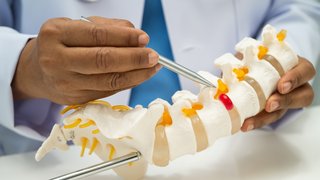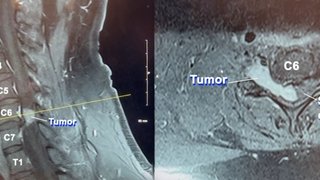Adult scoliosis can be a pain in the back and legs
August 1, 2019

Just like the padding in our knees wears down over time, so can the cushioning in our spines. In some adults, this can result in a side-to-side curvature of the spine – a condition called adult degenerative scoliosis.
Adult scoliosis is different from idiopathic scoliosis, which typically affects children and teens. Idiopathic scoliosis can develop without an apparent cause and accounts for approximately 80% of scoliosis cases in the U.S.
Adult degenerative scoliosis is a wear-and-tear breakdown of the spinal discs and joints that results in shifting and twisting of the vertebrae. As the degeneration progresses, the spine can become more out of balance, resulting in back and leg pain. As adults live longer, more active lives, we’re seeing an increase in cases of adult scoliosis.
According to The Burden of Musculoskeletal Diseases in the United States, approximately 5.88 million adults in the U.S. have adult scoliosis, though some estimates suggest that number could be as high as 141 million because rates of the disease are not well reported.
“Adult degenerative scoliosis is a wear-and-tear breakdown of the spinal discs and joints that results in shifting and twisting of the vertebrae. As the degeneration progresses, the spine can become more out of balance, resulting in back and leg pain. As adults live longer, more active lives, we’re seeing an increase in cases of adult scoliosis.”
Carlos Bagley, M.D.
Patients are typically in their 60s and 70s, and many are thinking about retirement and actively involved in physical activities such as playing golf, running, and chasing after grandchildren.
Low-back pain and stiffness can put a damper on those plans. However, back pain often isn’t the symptom that brings patients into the Spine Center – often, it’s severe leg pain.
How can adult scoliosis affect the legs?
In adults, scoliosis is an acceleration of the aging process in the spine. As the tissue degenerates, the spine begins to curve into a C-shape (if you look at the spine from the back) instead of the classic S-shaped curve of idiopathic scoliosis. The curvature causes a spinal imbalance, making it tough for patients to stand up straight, walk, or run without pain.
Spinal stenosis, a narrowing of the spinal canal, is often paired with adult scoliosis. It causes compression of nerves in the spine, which results in shooting pain, tingling, heaviness, weakness, and numbness in the buttocks and the legs – a cluster of symptoms more commonly known as sciatica.
My Aching Back: Solving the Pain Puzzle
Dr. Carlos Bagley, director of the UT Southwestern Spine Center, discusses back pain, one of the biggest "time thieves" in medicine, and how treatment is evolving to get patients feeling better, faster.
What treatment options are available?
Treatment options and outcomes for adult scoliosis have improved significantly over the years. Just a few decades ago, we could successfully treat scoliosis only in children and teens. Today, we know that multimodal treatment – a team approach and combinations of therapy – is the best way to treat adult scoliosis and prevent recurrence of symptoms.

While back braces might be effective for scoliosis in children, it’s not a primary treatment for adults. Sometimes we recommend bracing to stabilize the spine during acute episodes of pain. But long-term bracing can do more harm than good in adults. It can weaken back muscles because they don’t have to work to support the torso, putting additional stress on the discs in the spine and speeding up degeneration.
Physical therapy (PT) is the first-line treatment for adult scoliosis, which sometimes surprises patients if their backs or legs hurt during activity. A physical therapist can help patients develop proper back mechanics to minimize stress on the spine when lifting, bending, and exercising.
We also recommend other non-surgical approaches, such as acupuncture or dry needling and anti-inflammatory injections to help manage symptoms. Some patients benefit from getting epidural steroid injections to reduce the inflammation affecting the nerves and reduce sciatica pain.
Related reading: Back in action: Updated treatment recommendations for lower back pain
Most patients won’t need surgery – we typically recommend it only in severe cases or if conservative treatments don’t work. Scoliosis surgery involves rebalancing the spine to restore its natural curvature, as well as decompressing pinched nerves. We also emphasize post-operative PT for every patient as the foundation of their rehabilitation program after surgery to help maximize and maintain their results.
As mentioned, most of our adult scoliosis patients are in their 60s and 70s. Many of them have other medical issues we need to consider in their treatment plan, such as high blood pressure or diabetes. We take a team approach to treating patients that utilizes the latest in evidence-based techniques to help enable patients quickly return to health and enjoy their retirement years.
Prevention is key
As with many spine conditions, mindful prevention is key to avoiding adult degenerative scoliosis. Staying active, such as participating in yoga and Pilates, can be beneficial as well. Both types of exercise are gentle on the spine while strengthening the core muscles in the abdomen and back.
Day-to-day repetitive motions over the years affect our level of spine pain, from sitting at a desk with poor posture to having improper body mechanics when lifting or bending. These habits can be tough to break but doing so can help control back pain symptoms and reduce the risk that it will return.
To find out whether you or a loved one might benefit from screening for adult scoliosis, call 214-645-8300 or request an appointment online.










